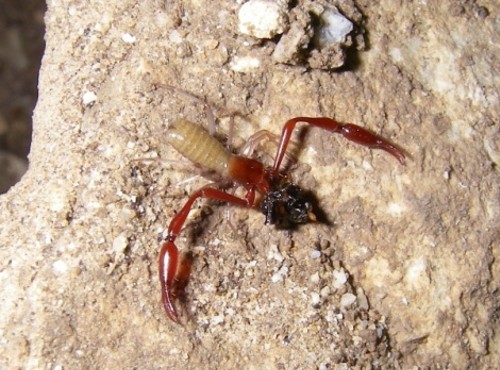Cave Dwellers
Tiny creatures below ground could cause big headaches for Nevada water grab
By Jesse FruhwirthTucked deep inside sometimes-flooded and frequently undulating caves of Great Basin National Park are several rarely-seen troglobites, or creepy cave creatures that never see daylight. Now, some worry a proposed 285-mile pipeline to service Las Vegas that would pump water from beneath the park and Snake Valley in western Utah could dry out the habitats for these creatures before science can formally prove that they even exist.
The Lehman Caves Millipede, for example, has no scientific name yet because taxonomists are still “describing” it in such a way that its uniqueness can be confirmed by the scientific community. Other species that have been described, and are believed to exist no where but within the park's 42 caves, could also be threatened if water levels drops, said park ecologist Gretchen Baker.
“They are species, new to science, that live nowhere else in the world. If they lose their habitats here, no one will have a chance to see them or know about them,” Baker says. “They probably play a role in the ecosystem we don't understand yet.”
Great Basin National Park is in eastern Nevada, 95 miles west of Delta, Utah. The Snake Valley is to the east of the park, straddling the state line. Spring Valley, another site the Southern Nevada Water Authority hopes to exploit, is west of the park in White Pine County, Nevada.
A draft resolution between Nevada and Utah regarding the pipeline—and how much water each state is entitled to—is currently being considered. The current draft contains a 10-year moratorium on taking water, but that resolution has not been finalized.
In the meantime, park officials are continuing a decade-long inventory of the park's natural resources, including ecosystems that rely on the park's groundwater and animals that live there. Baker said collecting the unique animals doesn't take too much time, even though it involves spelunking tight caves that are not open to the public and carrying out specimens.
“The long part is finding somebody who can identify all those things, because to have a new species described, you have to have a taxonomist that specializes in that family,” she said. That search has lead the park to ship little critters to experts in Brazil, the Czech Republic and all over the U.S. “We just have to wait until the taxonomist gets to them.”
Dan McGothlin leads a National Park Service hydrology team that is examining the park's streams with pumping tests. Earlier research by the U.S. Geological Survey suggested several areas of the park could be affected by the proposed water pipeline because they are hydrologically related to the valleys below. McGothlin's team is inserting pumps in some of these areas, then measuring whether, and to what degree, nearby streams are impacted.
The places where they have applied to take those large amounts of water are right on the doorstep of Great Basin National Park. So our concern is that there will be an impact of the pumping at those locations on park resources."
Another animal that may be threatened if the park dries out, Baker said, is Bonneville cutthroat trout, a native species of the park's streams, some which appear to be fed by groundwater stored in the Snake Mountains.
The concern is that the pumps to serve Las Vegas may act like a hole in a large sink. While the hole is relatively small compared to the entire basin, the impact of the dropping water levels impacts a much larger area above. Researchers are studying which parts of the park are connected to the basin below it.
Baker concedes that many of the cave dwellers may be less impacted than others by a drop in the water table. That's because most of the caves are not hydrologically related to the Snake and Spring valley aquifers and flood due to snow melt. But another natural process special to the park could be stopped by water loss.
Right now the water table is forming new caves right under the current caves,” she says. “As we sit and talk, it's dissolving the limestone rock.”
Public meetings regarding the water studies are planned for Nov. 4 in Ely, Nev., and Nov. 5 in Baker, Nev. Other public meetings, attended by Utah governor Gary Herbert, happened at the end of September.
More by Jesse Fruhwirth
-
Johnny's Rotten
Johnny Bangerter wants to move forward as an activist but just can't shake his racist punk past
- Apr 10, 2013
-
Right of Way
Eviction of Occupy SLC is a loss for community
- Nov 23, 2011
-
The Limbo Party
Redistricting: How low can Utah Dems go?
- May 19, 2011
- More »
Latest in News
Readers also liked…
-
Raise a glass for E.L.T Harrison, architect of the Beerhive building on Main
Small Lake City
- Oct 11, 2023




